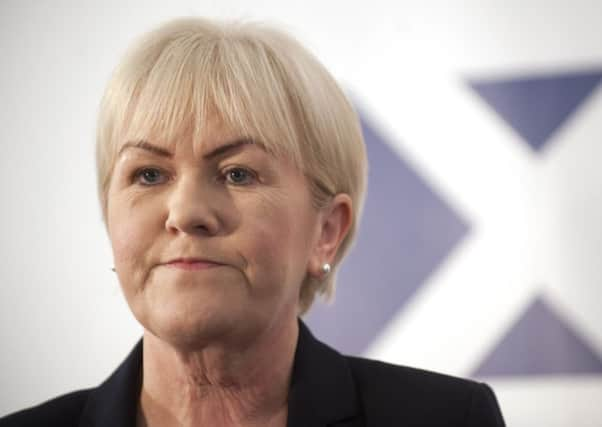Scottish independence: ‘Mortgages up £1600 if Yes’


In a keynote speech in Glasgow yesterday, Ms Lamont also said Mr Salmond’s threat to default on an independent Scotland’s share of UK debt if a formal currency union is vetoed by Westminster would send mortgage rates through the roof and make repayments even higher.
Her warning heaps further pressure on the First Minister to set out an alternative plan to a currency union. Last week Labour leader Ed Miliband confirmed his party’s 2015 general election manifesto would include a pledge to block an independent Scotland from formally sharing the pound with the UK. The Conservative and Liberal Democrat leaderships at Westminster have made similar pledges.
Advertisement
Hide AdAdvertisement
Hide AdIn a newspaper article yesterday, Mr Salmond accused the main party leaders at Westminster of “playing with fire” and “bullying” the Scottish electorate.
Ms Lamont set out the risk to families of independence as she stated that a No vote on 18 September would allow Scotland to “lead the UK, not leave the UK”, using devolution to redistribute wealth, boost job creation and strengthen the NHS.
Warning that the security of the UK as a guarantor for Scotland’s debt would be lost if an independent Scotland used the pound in an informal currency union, she said: “Those are some of the things which we would lose if we voted to leave the United Kingdom. And what would we gain? For the average family, nothing but negatives.
“We are still waiting for the First Minister to tell us the basic of what currency we would have in an independent Scotland. But whether it is the groat, the bawbee or a currency union with the Armenian dram, what we can be assured of is that our interest rates would be higher.
“Let’s say you have a mortgage of £80,000. Independent analysts have said that interest rates in a separate Scotland would be 1 to 2 per cent higher than in the rest of the United Kingdom – and much higher than that if Alex Salmond follows through on his threat to default on Scotland’s debt. A 1 per cent rise would mean families having to find an extra £800 a year to keep their homes. A 2 per cent rise would mean an extra £1,600 a year for the privilege of living in Salmond’s Scotland.”
Ms Lamont went on to suggest that a No vote would make it easier to tackle inequality by redistributing wealth from other parts of the UK to Scotland.
She told the invited audience of 200 at Kinning Park Complex that Scotland would face an “additional wave of austerity” after a Yes vote with a gaping hole in the SNP’s plan to fund public services and protect jobs.
She said: “We will not be bought and sold for Salmond’s fool’s gold. Instead we will use the strength of the United Kingdom to make Scotland stronger.
Advertisement
Hide AdAdvertisement
Hide Ad“Poverty is our enemy, not our neighbours. And we don’t need to destroy one country to change our nation.”
She added: “On September 19, we face two futures: one, where we put ourselves at a disadvantage and take on all of the risk that has been set out today on currency, on jobs, on pensions, and on our NHS. Or we use the strength of the United Kingdom and the opportunity of devolution to achieve our goals for Scotland. That is the future I believe in. One where we lead the UK, not leave the UK.”
But SNP MSP Jamie Hepburn dismissed Ms Lamont’s claims as “bizarre” and said: “Ms Lamont’s claims aren’t just wrong, they are also the height of hypocrisy from a Labour leader who is working hand in glove with the Tories in the No campaign.
“A Yes vote in September is our one opportunity to escape from Westminster’s austerity agenda and to invest Scotland’s wealth in making our country fairer and more prosperous for everyone who lives here, and we should grab it with both hands.”
Mr Salmond has argued that the pound is as much Scotland’s currency as it is the rest of the UK’s and that an independent Scotland would have as much right to use it as the rest of the UK. But he has repeatedly declined to outline his “Plan B” or say whether a future Scotland would operate a “Panama-style” arrangement in which Scotland would continue to use the pound unofficially, launch its own currency or join the euro.
Writing yesterday in the Sunday Herald newspaper, which supports independence, Mr Salmond attacked suggestions Scotland had “zero entitlement” to share the pound and dismissed interventions from Westminster politicians as “more kamikaze than convincing”.
He wrote: “The No campaign’s tactic of saying no to a currency union makes absolutely no economic sense. But it also makes no political sense.
“They… risk neglecting a cardinal rule of political campaigning, namely not learning your lesson from past mistakes.
Advertisement
Hide AdAdvertisement
Hide Ad“When George Osborne came north earlier this year to deliver his ‘sermon on the pound’, the effect on the independence debate was instantaneous. The Scottish electorate decided to stand up to the bullying diktat from Westminster, and support for independence in the polls shot forwards.”
Meanwhile, Deputy First Minister Nicola Sturgeon will highlight the SNP’s welfare system plans for an independent Scotland on a visit to a foodbank in Glasgow today.
Ahead of her visit, Ms Sturgeon said: “Independence is not a magic wand, but it means control of key decisions that affect Scotland lie here and not with Westminster politicians. It is a scandal that so many children in wealthy Scotland are reliant on emergency food aid as a direct result of Westminster cuts.”
Elsewhere, the anti-independence Scottish Research Society has claimed that a Yes vote would cost every Scottish household between £3,400 and £5,500 a year due to European Union borrowing limits, declining oil revenues and the loss of the UK’s financial support.
SEE ALSO